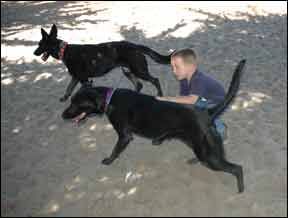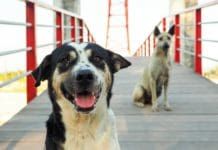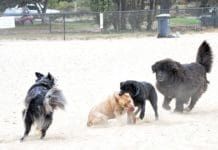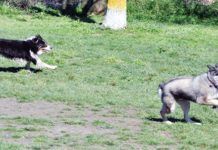[Updated January 16, 2018]
Dog parks have gotten a bad rap in the past few years, thanks in large part to articles written and statements made by training and behavior professionals. That’s unfortunate, because, while there are, indeed, problems with some dog parks, a well-run facility can be a lifesaver for some dogs.
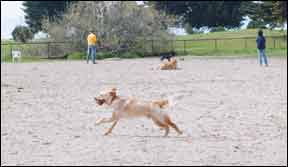
These days, most dog park administrators understand the need for rules that purport to regulate, at least to some degree, the behavior of the canines and humans who avail themselves of the dog park privilege. Problems arise when there’s no one in attendance to monitor the action and enforce the rules. Some parks run well on a peer-pressure basis, but this format often acts only to evict an offender after a problem arises – sometimes a serious one – rather than screening users in advance to prevent problems.
The majority of official dog parks are municipally owned and operated. I am always delighted to see communities recognize that dog owners and their canine family members are as deserving of a slice of the local park pie as are soccer players and Little League teams. However, very few municipally run dog parks provide adequate supervision. They put up the fence, post signs with rules, and keep the grass watered and mowed, and that’s it. When problems arise, animal control is called, and the issue may or may not be resolved to everyone’s satisfaction.
The ideal model for a successful dog park is a privately owned or very well-supervised municipal facility where dogs are screened before being accepted and owners are issued membership cards that they swipe to gain entry through a locked gate. The park should have at least one attendant on duty during park-use hours, to intercede, hopefully before a problem behavior becomes serious, but if not, at least to manage the situation after something occurs.
Off-Leash Dog Parks: How Humans Should Behave
Half the problems (or should I say at least half the problems) at many dog parks stem from human behavior rather than dog behavior. When you take your dog to a park your primary responsibility is to keep your eyeballs on her and intercede if/when things are getting dicey.
There can be a fine line between two dogs happily playing body-slam and chew-face, and the moment one decides he’s had enough and things escalate to real snapping and snarling. If you and your dog-owner friend are drinking wine and chatting with your backs to the action, you’ll miss the early warning signs that trouble is brewing, and lose the opportunity to intervene before things turn ugly. Oops, too late! Now there’s a full-blown dogfight, and you’ve lost your dog park privileges. Turn in your membership card!
Rule-ignoring is also a problem. See that 85-pound Shepherd in the small-dog area? That’s a tragedy waiting to happen. The owner who is blithely feeding her dog pieces of chicken while her toddler tried to hug the pretty doggies, even though the sign says “no treats in the off-leash area” and “no children under 8”? Another disaster in the making. Maybe two or three.
Well-run parks have paid staff whose job it is, among other things, to make sure dogs and humans play by the rules. Parks that aren’t staffed are likely to have a much higher rate of unfortunate incidents than those that do, thanks in large part to those oblivious owners who think that rules only apply to others. If you plan to play in the park with your dog, be sure you’re not one of them.
What Dogs Do Best at the Dog Park?
Perhaps you are fortunate enough to have a well-run dog park in your community. How to do you if your dog is a good dog park candidate? For starters, she must already play well with others. A dog park is for socializing, not for socialization. It’s a terrific place for a dog who already understands how to read and respond appropriately to the body language of other dogs. It’s a great place for a dog who enjoys the company of other dogs and likes to engage in appropriate play. It’s not the right place for a dog who is socially challenged. The undersocialized dog needs to learn those skills elsewhere, and may never be comfortable with rowdy play styles of unknown stranger dogs in a dog park setting.

If your dog is undersocialized, she needs to learn her canine social skills in a more controlled environment than a dog park. Pair her with one appropriate dog, who will tolerate her social ineptness. If yours is a little shy, a calm, stable adult dog can help her learn that other dogs are okay, maybe even fun to be around. If yours is a Rowdy Roberta who never learned when to back off, a more energetic playmate is in order, but one who will politely, firmly, and without taking offense, tell your dog when enough is enough. In time, you hope, she will learn to self-inhibit her over-excited play, and be ready for group action. Or not. Some dogs are never good candidates for dog park membership.
It’s perfectly normal for some dogs to eschew group play even from an early age. Others start out in life happy to play with all comers, but as they mature, decide they’d rather have a small circle of intimate play partners rather than interact with the canine hoi polloi found at most dog parks. Dogs who love to romp with any and all takers for their entire lives are the exception rather than the rule in the canine world – really not all that different from humans in that respect, when you think about it.
If you have any doubts about your dog’s suitability for dog-park-play, get an outside opinion. Ask a competent dog behavior and training professional or a very dog-knowledgeable friend to evaluate your dog’s social skills before taking the park plunge and risking an incident that could put your dog and others at risk of harm. It could be a costly mistake if your dog attacks another and you end up paying vet bills and dancing to the often-onerous demands of your local dangerous dog ordinance.
If you do think your dog is a good park candidate, be sure you’re making an honest assessment. It’s easy to be blinded by your love for your canine pal. Unless he has a history of playing well with lots of dogs in a wide variety of situations, approach your dog park experience with caution. Make his first visit to the park at a low-usage time, perhaps accompanied by that dog-knowledgeable friend who can help you interpret his behavior around other dogs and assist with intervention should things not go according to plan. You cannot be too careful. And remember that dogs don’t have to go to dog parks.
Pay Attention to Your Dog’s Behavior and Body Language!
Some dogs seem to be eternal victims at the park, as if they have an invisible (to us) “kick me” sign taped on their backs. They may or may not put out aggressive signals; tense, nervous, or submissive behavior may also elicit bullying responses from some other dogs. The value of exercising at the park may be negated by repeatedly subjecting a dog to this treatment.
Qualities of a Good Dog Park
If you’re fortunate enough to have a dog park in your community and a dog who plays well with others, your last step before actually taking her to the park is checking it out to be sure it’s a good place to take your canine pal. Here are some things to look for:
Space and Fencing
The best parks are several acres or more, and are enclosed by a sturdy, well-maintained fence that’s at least six feet high, perhaps with an anti-climb device on the top, and preferably buried in the ground at the bottom. If the area is too small for the number of dogs, there is a greater risk of canine conflict; the more space there is, the easier it is for a dog to avoid dogs that make her uncomfortable. And, of course, good fencing prevents escapes.
Another vital escape-protection and safety measure is an “airlock” system of gates, where dogs and their humans enter the park into a small enclosed space with another gate to the actual park run area. The owner removes the dog’s leash in this airlock, checks to be sure the gate behind her is latched, and then opens the gate into the park. This prevents dogs from slipping out when a new dog enters the park, and also avoids the “one dog on-leash being mauled by a pack of loose dogs” scenario that can give rise to aggression and fear-causing incidents.
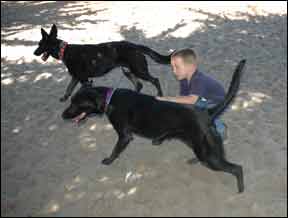
There should be at least two separately fenced areas in the park, clearly designated for large and small dogs, and owners should respect the designations. Even better: four or more separate areas clearly defined by size and play-style, so dogs who enjoy a good game of “chase me” aren’t being tackled by body-slammers.
Maintenance
Upkeep of the facility is another important consideration. Scrutinize the conditions of the park. Is the grass mowed and nurtured, or is the park a muddy mess with overgrown weeds? There are some parks that are kept in a more natural state – especially parks that are larger and include woods and meadows and real hiking trails, but the entrance and social area should still be well maintained. If there’s equipment for dogs to play on, it should also be kept up – painted, no splintered or rotten wood, and no exposed nails.
Rules
All good dog parks have rules. They should be clearly posted in plain view and obeyed. The best parks have someone in attendance to monitor rule compliance as well as user comfort and safety. Some assign their human users a numbered armband that they are required to wear when using the park so if there is an incident of some kind the culprit can be easily identified. Read the rules to be sure you are willing and able to comply with them before taking your dog to the park.
Ambience
Visit the park at several different times of day without your dog. You’ll see usage patterns – low, high, and moderate-use times throughout the day. You may also see specific groups of dogs who tend to come at fairly fixed times. With this information you can make deliberate decisions about when you want to bring your dog (high or low usage) and which groups of dogs might be the best match for her (and which dog owners you might most like to hang out with – it’s a social outing for you, too!).
If everything looks positive after your fair and careful assessment of the park and your dog, you’re in luck! Now it’s time to go to the park with your dog. Pick a low usage time at first, even if you’re convinced she will have a blast with the group of six-to-eight dogs that normally gathers at 6 pm.
Do this a few times, at least, until she’s clearly delighted to be there. This will give her a chance to explore and get comfortable with the environment without being mobbed and overwhelmed. Her introduction to the 6 pm group will go much more smoothly if she’s not distracted and wondering where the heck she is. The positive association she gets from being and playing there without being stressed by a pack of dogs will help her through any stress that may arise as a result of being greeted by multiple dogs.
When you’re ready for 6 pm, stop by at that time, again without your dog, and let the group know you’ll soon be a newbie in their group. Tell them about your dog, to help ease any concerns they may have about an addition to the 6 pm club.
When you do bring your dog, get there early, assuming there’s less dog traffic while everyone is still at work. Let her run and work off some energy while you’re waiting for the others to arrive. This way she gets to meet and greet them one-at-a-time instead of in a bunch. This is likely to make introductions go more smoothly.
For appropriate dogs, the opportunity to run, play, and socialize with other dogs can be a real blessing to canines and their humans. I still have fond memories from when I was working at the Marin Humane Society (Novato, California) 15-plus years ago of the “dog-pack hikes” that staff would take with their dogs at the nearby off-leash open space areas. We all would return from that lunchtime hike in the hills, dogs tired and humans more relaxed, much better able to deal with the stressors of shelter work.
If you have a good dog park in your community, and a dog who is suited for dog-park play, go for it! If your dog-park-worthy dog doesn’t have a park place to play with his pals, maybe you can get dog owners in your community to rally together to start one, or talk your local positive dog trainer or pet supply store into launching a private park. If all else fails, start one yourself!
IS THE DOG PARK SAFE FOR YOUR DOG?
1. First check out your local dog park without your dog, to determine if it’s a well-run facility and a safe environment for you and your dog.
2. Make an honest assessment of your dog’s ability to play at a park. If you’re not sure, ask a knowledgeable dog person to assess her park-play potential.
3. Be responsible. Follow the rules, and be attentive to your dog’s behavior at all times so you can intervene when you see early warning signs of pending problems.
Pat Miller, CBCC-KA, CPDT-KA, is WDJ’s Training Editor. She is the author of many books on positive training, including, Do Over Dogs: Give Your Dog a Second Chance at a First-Class Life.


